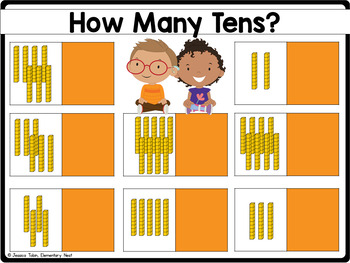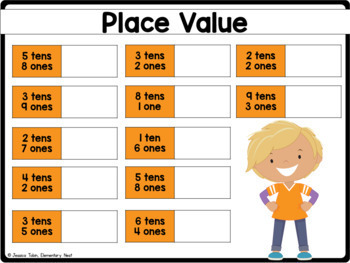Place Value Digital Games Activities - 1st Grade Math Place Value Google Slides
- PDF
- Google Apps™
- Internet Activities

Description
This is a digital math activity for place value. The activities comes ready-made in Google Slides. The resource aligns with the a few of the 1st grade Common Core Math Standards in the Numbers and Operations in Base Ten (NBT). Topics covered are place values (hundreds, tens, ones), base-ten blocks, expanded form, number names, representing numbers, skip counting by 5s, 10s, and 100s, and comparing numbers.
When you download the file, you will open a PDF. The link to Google Slides is available on page 4 of this PDF file. Please read through the instructions and guided pages to learn how to open, save, and share with your students.
- A page with instructions on how to save the PowerPoint version is also added into the PDF. This would be for teachers wanting to upload pages to their own Seesaw, Canva, or other platform outside of Google Slides.
Activities Included:
- Base-Ten Blocks: Ones
- Base-Ten Blocks: Tens
- Hundreds Chart Cut-Outs
- Ten Frames: Teen Numbers
- Reading Number Names: Teen Numbers
- Base-Ten Blocks: Teen Numbers
- Finding Sets of Ten & Counting
- Place Value: Tens and Ones
- Place Value: Tens and Ones (written out)
- Base-Ten Blocks: 2-Digit Numbers
- Matching Numbers to Number Names
- Reading Number Names: 2-Digit Numbers
- Writing Out Number Names
- Expanded Form Matching
- Expanded Form Writing
- Comparing 2-Digit Numbers
- Comparing Numbers: True or False
Standards Covered:
- 1.NBT.B.2 - Understand that the two digits of a two-digit number represent amounts of tens and ones. Understand the following as special cases:
- 1.NBT.B.2.A - 10 can be thought of as a bundle of ten ones — called a "ten."
- 1.NBT.B.2.B - The numbers from 11 to 19 are composed of a ten and one, two, three, four, five, six, seven, eight, or nine ones.
- 1.NBT.B.2.C - The numbers 10, 20, 30, 40, 50, 60, 70, 80, 90 refer to one, two, three, four, five, six, seven, eight, or nine tens (and 0 ones).
- 1.NBT.B.3 - Compare two two-digit numbers based on meanings of the tens and ones digits, recording the results of comparisons with the symbols >, =, and <.
For more 1st Grade NBT units, check these standards-aligned lesson sets:
- NBT: Place Value 1st Grade Printables
- Numbers and Operations in Base Ten Centers
- NBT: Place Value Short Answer
- Numbers and Operations in Base Ten Interactive Notebook
This resource includes 52 slides on math practice.
This purchase is for one single classroom only.
If you're interested in sharing with other classrooms, make sure to buy the extra licenses for a discount through the TeachersPayTeachers tool. If you are interested in a site license, please contact me for a quote at jessica.L.tobin@gmail.com.





